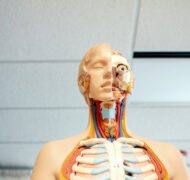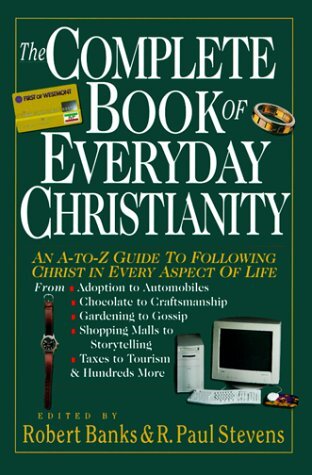Body
Book / Produced by partner of TOW
God is the author and creator of our bodies. The well-known passage in the first chapter of Genesis powerfully portrays the creation of man and woman in the Maker’s own image. Bearing that image, they are living persons, clothed in all the intricacies of the body: organs, blood, muscles, flesh, bones and body language. The body is integral to being human. Even the simplest of tasks requires numerous and complex bodily systems to be working: circulatory, auditory, muscular, nervous, glandular, sensory, kinesthetic and respiratory.
And God Breathed: Spirit and Body
God is the most superb craftsperson, as Psalm 139 so aptly describes, “For you created my inmost being; you knit me together in my mother’s womb. . . . I was woven together in the depths of the earth” (Psalm 139:13, 15). Who but God could weave this body-spirit? The body has been woven by a proficient artist, and the finest architect or biologist cannot duplicate what God has created. The metaphor of a weaving vividly captures the body’s connection with the spirit. In weaving, the warp threads run vertically, and the weft threads run horizontally. Both are needed: they can be spoken of as separate, yet the weaving can only “be” a weaving if the warp and weft are both there.
God breathed into man and woman the breath of life; bones and flesh became enlivened with spirit. The creation story tells us that God made us from the dust of the ground, the humus of the earth, and breathed life into our very bones: “God breathed in the nostrils the breath of life, and the human became a nephesh [soul]” (Genesis 2:7; translation mine). The passage does not say that the human was supplied with a soul as some other attachment to the body, but that by the breath of God, the human became a living body-soul, a living human being. The body (weft) connected with spirit (warp) makes us human.
Breath is a physical reminder to us that we were “inspired” into being by God. The Hebrew understanding of the breath is closely associated both with the soul and with human desire. The psalmist proclaims, “Let everything that breathes praise the Lord!” (Psalm 150:6 NRSV).
The Body in the Old Testament
Old Testament anthropology in general reveals a close relationship between the soul and body. The Hebrews regarded the person as a totality: body can be spirit, and spirit can be body. Though they could differentiate between various aspects of a person, the Hebrews believed that human beings operate as integrated, connected and embodied people. Nowhere is this more apparent than in the interchangeable Hebrew terminology for the words heart, breath, soul, flesh, bones and so on. We see a language that is bodily and gutsy, one in which the flesh can cry out or long (Psalm 84:2; Psalm 63:1), bellies can grieve (Psalm 31:9), bowels groan (Jeremiah 31:20) and bones can proclaim, rejoice and tremble (Psalm 35:10; Psalm 51:8; Jeremiah 23:9). Body parts are constantly used to express the innermost yearnings, the heartfelt prayer to God.
Given this, it is understandable that Jewish prayer was expressed through bodily gestures and postures. In the Old Testament we find crouching movements of lament (Psalm 44:25), bowing and kneeling (Psalm 5:7; Psalm 95:6), acts of falling prostrate (Daniel 8:17-18), lifted hands (Psalm 63:4) and jubilant leaps of celebration (2 Samuel 6:14-16, 21). Inward grace was made visible through physicality—theology was transformed to doxology.
The Body in the New Testament
Physicality is the same in the New Testament. Lifting hands was encouraged by Paul (1 Tim. 2:8); kneeling was demonstrated by Jesus (Matthew 26:39; Luke 22:41); and dance was used to celebrate the return of the prodigal son (Luke 15:11-31). God came to bring salvation not only to the soul but to the whole person. The word for salvation itself, sōsō, is sometimes rendered “save” and sometimes “heal.” Both senses show that God is concerned with the physical dimension.
The highest affirmation of the physical is in the incarnation of Jesus Christ. As the Gospel of John says, “The Word became flesh and dwelt among us” (John 1:14 RSV). God became a living body and made a home among us: living, breathing, eating, celebrating and mourning with women, men and children. God became known through human flesh, breathing and pulsing with all the limitations and capabilities we have, miracle and mystery twined together. Jesus fulfilled his earthly vocation through his body: walking among the poor, kneeling in prayer, eating with sinners, washing feet, healing the sick. Jesus’ hands became a living extension of the heart of God; his bodily touch was central to loving and transforming people while on earth.
Christianity’s regard for the body is stated so well by C. S. Lewis: “Christianity is almost the only one of the great religions which thoroughly approves of the body—which believes that matter is good, that God himself once took on a human body, that some kind of body is going to be given to us even in Heaven and is going to be an essential part of our happiness, our beauty, and our energy” (Lewis, p. 91). The centrality of the incarnation and resurrection affirms the body as part of God’s intentional design, not only for our creation but also for our recreation. We are our bodies, and if God can honor the body enough to be revealed through it and to redeem us in flesh, we need to take the body seriously.
The Body in Everyday Life
Our bodies are very much like breath—so much a part of us we don’t recognize them unless they are distressed or ill. Our bodies remind us of a paradox: they are filled with wonder but have limitations. They are also fragile: Paul reminds us that “we have this treasure [God’s power] in clay jars” (2 Cor. 4:7 NRSV). Bones, like clay, can be broken and cracked. Bodies succumb to everyday annoyances of colds, stress, fatigue and disease. Bodies are not perfect but can be a spiritual reminder of the One who created and will transform us.
Our bodies are also the place of delight. They enable us to feel the wind on our faces, the warmth of a hug, the joy of moving. Many of us experienced this far more when we were children, in the days when we were not as self-conscious about “body image.” Children engage physically in their world, rejoicing that they can skip, run and hop to a dance of their own. Arms reach, knees bend, legs climb, torsos slide, and bodies swing with sheer joy as children play. But it does not take long for them to “learn” that being a bodily being has more to do with appearance than how one engages in the world. The emphasis on body image stresses the split between body and heart, relegating the body to a shell or container. In contrast, many of the subjects taken up in this volume are bodily activities that can be expressive of true spirituality: eating, sleeping, washing, walking, adornment, dressing and sexuality.
It is not surprising that as adults we find it difficult to put body, soul, mind and heart in balance. At times we emphasize the body to the point of neglecting the heart. Physical exercise and toning can never ultimately bring about toning of the spiritual life, and neglect of the body can wreak havoc with the wholeness that God intended for us. We divide ourselves as if we were two separate organisms, each unaffected by the other. Western culture is bombarded with images from the media that reveal a fragmented attitude toward the body. This has seeped into core attitudes toward the body, self-concept and relating to each other and God. These dualistic attitudes are nothing new and have been an ongoing theme in Western culture for centuries.
Western philosophy was loosely built upon this dualism. In classical Greek thought the body was equated with irrationality and viewed as an obstacle to seeking the higher attributes of truth and beauty. Plato refers to the body as a prison of the soul, defiling it and inhibiting its ability to know the divine. Such thinking affected the fathers of the early church. Scripture was eventually read through “dualistic world view glasses” (Walsh and Middleton, p. 109). This leaves little room for the human being to feel at home with his or her body or for embracing the reality that our bodies are a gift from God through which we can fulfill our God-given vocation.
In contrast, the biblical realities of creation, incarnation, redemption and resurrection affirm that we were masterfully designed as complete and complex creatures—the physical and spiritual intertwined. The biblical concept of the body celebrates this interconnection. We honor God and ourselves when we affirm the goodness and wholesomeness of God’s work in us.
» See also: Adornment
» See also: Breast-Feeding
» See also: Circumcision
» See also: Healing
» See also: Health
» See also: Jogging
» See also: Menstruation
» See also: Sickness
» See also: Walking
» See also: Washing
References and Resources
P. Brand and P. Yancey, Fearfully and Wonderfully Made (Grand Rapids: Zondervan, 1987); J. W. Cooper, Body, Soul & Life Everlasting: Biblical Anthropology and the Monism-Dualism Debate (Grand Rapids: Eerdmans, 1989); C. S. Lewis, Mere Christianity (New York: Macmillan, 1943); C. S. Schroeder, Embodied Prayer: Harmonizing Body and Soul (Liguori, Mo.: Triumph Books, 1994; portions quoted here with permission); B. J. Walsh and J. R. Middleton, The Transforming Vision: Shaping a Christian World View (Downers Grove, Ill.: InterVarsity Press, 1984); D. Willard, “Spiritual Life: The Body’s Fulfillment,” chap. 6 in The Spirit of the Disciplines (San Francisco: Harper & Row, 1988).
—Celeste S. Schroeder





